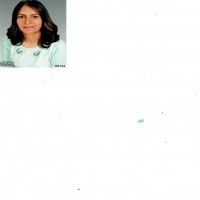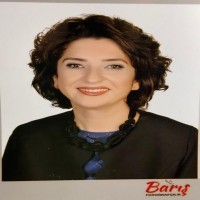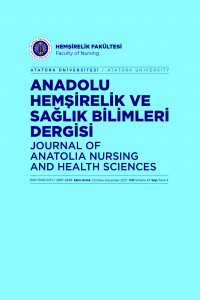Research Article
Review
Systematic Reviews and Meta Analysis
21. PANDEMİ SÜRECİNDE UZAKTAN EĞİTİMDE HEMŞİRE EĞİTİCİLERİN ROLLERİ VE ÖĞRENEN MERKEZLİ ÖĞRETİM STRATEJİLERİNE UYGUN WEB TABANLI ARAÇLARIN KULLANIMICase Report
Issue Editorial Board

 0000-0002-2728-5945
0000-0002-2728-5945

 0000-0003-0330-9807
0000-0003-0330-9807


Aim & Scope
The aim of this journal is to publish the results of researches that are conducted in different levels of evidence such as experimental, descriptive, case presentation and systematic review of researchers in the fields of health science such as midwifery, nutrition and dietetics, especially in nursing science, to contribute to the world of science.
Posted articles Medical Index of TUBITAK-ULAKBİM Turkey, Turkey Citation Index, Google Scholar, EBSCO CINAHL Database is scanned.
The journal publishes original research articles, case reports and reviews prepared in the fields of Nursing (Fundamentals of Nursing, Internal Medicine Nursing, Surgical Nursing, Child Health and Diseases, Obstetric Women's Health and Diseases Nursing, Nursing Care, Nursing Education, Nursing Management, Public Health Nursing, Psychiatric Nursing, etc.) and Health Sciences (Midwifery, Nutrition and Diet, Child Development, etc.), which have been prepared in Turkish or English languages, not previously published in another journal or presented to another journal simultaneously.
Author Guidelines
Author Guidelines
All submitted manuscripts are peer-reviewed. The manuscript should not already have been published in a journal and should not be under consideration by any other journal. Submission of an article implies that it is unpublished work and that the essential content of the article, including tables and figures, has not been and will not be submitted for publication elsewhere before a publication decision is made by this journal. Aricle presented at the congress or symposium should be stated as a footnote on the first page. The maximum similarity of articles submitted for publication in the journal is 15%. Authors should check this rate in the plagiarism analysis program before submitting an article to the journal.
Necessary corrections regarding the writing rules are forwarded to the authors by the journal secretary in the preliminary evaluation. The corresponding author is responsible for the entire content of the copy- edited article. The reviewers' reports are considered by the Editor who provides a summary report and a recommendation regarding publication.
Articles that are not prepared in accordance with the rules of writing are not evaluated and published. The journal makes no page charges for published article. The articles submitted to the journal for publication are not sent back whether they are published or not. However, articles for which a correction is requested may be returned for correction. Before submitting an article to the journal, the Copyright Transfer Agreement on the website should be filled in by handwriting, signed by all authors, and scanned and uploaded to the system. Research articles submitted for publication in the journal should have permission from the ethics committee and the number of ethics committee decisions should be written in the “Methods” section.
Manuscript Preparation
ü Articles should be written in Times New Roman font in Microsoft Word software. Manuscripts should be typed 11 fonts, 1.5-spaced.
ü Manuscripts should be prepared with a space of 4 cm at the top and left sides of the page, 3 cm at the bottom and right sides of the page, and should not exceed 14 pages in total. Other pages should be numbered except the first page.
ü The hierarchy of headings within the text should be clear, 12 fonts bold and short with capital letter. The heading must reflect content of manuscript. Authors should be written in the order of the article just below the title.
ü For Article; a) Title page, b) Manuscript, c) Blinded manuscript (name, address and other information about the authors are not written) should be uploaded to the system in three separate files. Each file is named “TITLE PAGE”, “MANUSCRIPT” and “BLINDED MANUSCRIPT”.
a) Title page; should contain article title, names of all authors according to their order in the article, degree, addresses, mobile phone numbers, e-mail addresses, ORCID IDs. Corresponding author should be mentioned separately.
b) In the article file; article title written in capital letters, first name (without degree), then last name (in capital letters). If the authors are more than one, they should be written side by side. At the end of the authors' names, numbers should be given as superscripts and these numbers should be used in footnotes. Degree, ORCID ID and institution(s) of the author(s) should be written at the bottom of the first page with the same font and 10 fonts as footnote.
c) Blank article; This is the file that does not contain any information about the authors.
ü Page 1 of the manuscript should carry Turkish and English abstract, the each abstract not to exceed 300 words. Turkish “ÖZ” and English “ABSTRACT” title (10 point and italic characters) should be used. ABSTRACT section includes Aim, Method, Results, Results should be structured under the headings. There should be no abbreviations and no references should be used. The abstracts should be followed by minimal three key words or short phrases for Index Medicus purposes. English keywords should be provided in accordance with Subject Medical Subject Headings (MESH). Turkish keywords Türkiye Bilim Terimleri (TBT) should be in accordance with what (http://www.bilimterimleri.com). The Turkish title of the study should be written in small letters and just below the ÖZ title in 10 font and bold character.
ü Original research manuscript includes
ü INTRODUCTION
ü AIM(S)
ü METHODS
ü FINDING AND DISCUSSION
ü CONCLUSIONS
ü ACKNOWLEDGE
ü CONFLICT OF INTEREST
ü REFERENCES
Main headings (when the paper has either one or two levels of headings) use centred uppercase and lowercase letters (e.g., Method, Results, Discussion, and References). Each heading should being 11 fonts and bold.
Methods contain study design, number and type of subjects, study population, measurement, intervention, ethics consideration, study limitation and type of statistical analysis.
The limitations of the research must be given before the title of results and recommendations.
Ethical responsibility: All research involving the human element must comply with the Helsinki Declaration Principles. In this type of research, the authors have to state that they conduct research in accordance with these principles in the material and method section of the article. Authors are required to state if financial support or funding from any institution is available for research. Authors are responsible for the compliance of the articles with ethical rules. The Ethics Committee Permission Letter of the article should be uploaded to the system. The date and number of approval must be given within the article.
ü Review articles: Abstract should be 200 words and should be written in Turkish and English. Subtitles, references sections should be included. Review articles; It should be prepared in a way to include the current literature for all kinds of subjects that are characteristic in all areas of health. It is preferred that the author has at least one published research on that subject.
ü Abbreviations must be written clear in first time use, and abbreviation must be given in parenthesis.
ü 9. Tables should be given in separate pages at the end of the article. Tables in the articles should be made using the table menu in Word program. Tables should be numbered consecutively with Arabic numbers, 1/2-spaced, and have a title at the top. Tables should be done form word table menu, and they should not contain vertical lines. The number of tables should not exceed 5. Tables should be written by dividing each value in the table into a row and column. To do this, "Table tools - Design / Layout --- Borders ---- all borders" should be enabled in the tables and make necessary adjustments to the table. Between fractions, there should be a period, not a comma (95.88).
ü The places where the figures, pictures, tables and graphics appear in the text should be indicated at the end of the relevant sentence.
ü In order to obtain clear print, images, pictures / photographs should be uploaded as separate .jpg or .gif files (pixel size approximately 500x400, 8 cm width and 300 resolution scans).
ü Abbreviations used should be indicated in the explanation under figures, pictures, tables and graphics.
ü Written permission should be obtained if the previously printed figures, pictures, tables and graphics have been used and this permission should be stated in the description of figures, pictures, tables and graphics.
ü The pictures / photos should be in color, with contrast and clear detail.
10. The writing languages of the articles should be clear and understandable.
11. Acknowledgments: If the articles contain conflicts of interest, financial support, donations and all other editorial (statistical analysis, English / Turkish evaluation) and / or technical assistance, they should be stated at the end of the text.
12. Conflict of Interest: The author (s) of the manuscript must declare that there are no conflicts of personal and financial interest within the scope of the study. They should state this statement under the title Conflicts of Interest at the end of the manuscript.
13. Contribution of the Author: It should be explained with clear expressions to which stages of the article all authors contributed. General expressions should not be used
14. References: At the end of the article, it should be numbered according to the order of transition in text, in accordance with the following rules.
References in Text
Vancouver reference style (numbering in citation order) should be used in the text. Numbering must be in parentheses. For example; ...... (1,2,11,25); ...... (5-8,13,21). Where the name of the author will be used, the surname of the author and the number of the source should be written in parentheses. For example; Özer (15). If it has more than one author, Özer et al. (18) should be.
References List
References appear on the page following the end of the text and must be Vancouver reference style (numbering in citation order).
Journal Article
Journal references must include names
and initials of all authors, title of article, name of journal spelled in, year
of publication, volume number, issue number, first and last page number.
If there are six authors, all of these
authors should be written.
For example:
✓ Tanabe P, Steinmann R, Anderson J, Johnson D, Metcalf S, Ring-Hurn E. Factors Affecting Pain Scores During Female Urethral Catheterization. Academic Emergency Medicine 2004;11(6):699-702.
If there are six more authors the first six followed by et al.
For example:
✓ Dexter P, Applegate M, Backer J, Clayton K, Keffer J, Norton B, et al. A Proposed Framework For Teaching and Evaluating Critical Thinking in Nursing. Journal of Professional Nursing 1997;13(3):160-7.
Book
For example:
✓ Underwood LE, Van Wyk JJ. Normal and aberrant growth. In: Wilson JD, Foster DW, eds. Wiliams’ Textbook of Endocrinology. 1 st ed. Philadelphia: WB Saunders; 1992. p.1079-138.
Chapter in edited book, multiple editors
For example:
✓ Solcia E, Capella C, Kloppel G. Tumors of the exocrine pancreas. Tumors of the Pancreas. 2 nd ed. Washington: Armed Forces Institute of Pathology; 1997. p.145-210.
Online document
✓ Bodur S, Filiz E. Validity and Reliability of Turkish version of ‘Hospital Survey on Patient Safety Culture’ and Perception of Patient Safety in Public Hospitals in Turkey. BMC Health Servives Research 2010; 10:28. doi:10.1186/1472-6963-10-28
Manuscript Submission https://dergipark.org.tr/en/pub/ataunihem
Ethical Principles and Publication Policy
Journal of Anatolia Nursing and Health Sciences is published four times a year. The journal publication's language is Turkish and English. The journal includes peer-reviewed original research, case report paper about all area of nursing. The journal does not charge for article evaluation and publication fees.It provides free open access to all articles in the journal. In addition, TUJNS support Budapest Open Access Initiative (BOAI). This journal uses the LOCKSS system to allow it to create permanent archives.
The authors agree that the article, if accepted for publication by the Journal will be licensed under a Creative Commons Attribution-NonCommercial 4.0 (CC BY-NC 4.0)
1. Publication and Authorship
a) Sources used in the article; The first source used in the text should be numbered 1 (vancouver). It should be presented with this numbering in the references section of the article.
b) If there are institutions or organizations that support the research, which is the subject of the article, an asterisk should be placed as a superscript at the end of the article title, and the necessary explanation should be made in the footnote of the first page of the article.
c) Articles sent to the journal for publication are checked with a program (ithenticate) suitable for similarity with articles published in different journals and various internet sources. As a result of the control, articles showing 15% or more similarity are rejected.
d) Articles determined to use false data in any way are rejected.
e) Articles previously published in another journal are not taken into consideration.
2. Authors' Responsibilities
a) The authors are obliged to have accepted the submission of the articles they submit to the detailed peer review process.
b) The authors whose names are included in the article must report their contribution to the editorial office.
c) Authors should prepare and submit their articles in accordance with journal rules.
d) Authors whose names are included in all articles submitted to the journal for publication are deemed to have declared that all the data in the article are real and original.
e) Authors cannot simultaneously send their articles to other journals that they have sent to the journal for publication.
f) The authors are obliged to make any corrections requested by peer reviwer and editors regarding their articles which have been evaluated by peer reviwer and editor.
g) In scientific studies sent to Atatürk University Journal of Anatolian Nursing and Health Sciences to be published; In the Material and Method section of the article, the expression “Ethics Committee approval has been taken” should be included. Author (s) should indicate the institution and approval number of the ethics committee.
h) The authors are obliged to comply with the copyright terms related to the material purchased or used from other sources and to sign the contract expressing the transfer of copyright to the Journal.
ı) All responsibility arising from the articles in the journal belongs to the author(s).
i) After being sent to the journal for publication, none of the authors can be deleted from the list of authors without the written consent of all authors, and no names can be added as authors, or the author's order cannot be changed.
3. Responsibilities of Peer Reviewer
a) Reviwers working in article evaluation should evaluate objectively and impartially.
b) Reviwers who have any conflict of interest regarding article authors or institutions and organizations supporting the article should not make an article assessment by reporting the situation to the editor.
c) Reviwers cannot share the data of the articles sent to them for evaluation.
d) Reviwers who believe that the article can be published by requesting a correction have the right to review the article after the necessary corrections are made.
4. Editorial Board Responsibilities
a) Preliminary evaluations of the articles are made by the Editorial Board.
b) Articles are sent to at least two reviwers by the Editorial Board for evaluation. Depending on the advisor's reports, the Editorial Board decides on the acceptance, rejection or revision of the articles.
c) The editorial office can send the article to a third reviwer when necessary.
d) The Editorial Board may in no way use the data of unpublished articles for their personal works and share this data in any way.
e) When the article evaluation process is completed, the editor transmits the decision to the responsible author.
f) When deciding on the acceptance or rejection of an article, the editor should not be affected by the conflict of interest with the person or persons named in the article.
Price Policy
Dergi makale değerlendirme ve yayınlama ücreti almamaktadır. Dergide yer alan tüm makalelere ücretsiz açık erişim sağlamaktadır. Ayrıca dergimiz Budapeşte Açık Erişim Girişimini (BOAI) desteklemektedir. Bu dergi, kalıcı arşivler yaratmasına izin vermek için LOCKSS sistemini kullanmaktadır.
Journal is listed in the EBSCO CINAHL Database since 2019.
Journal of Anatolian Nursing and Health Sciences is licensed under a Creative Commons Attribution-NonCommercial 4.0 (CC BY-NC 4.0)

